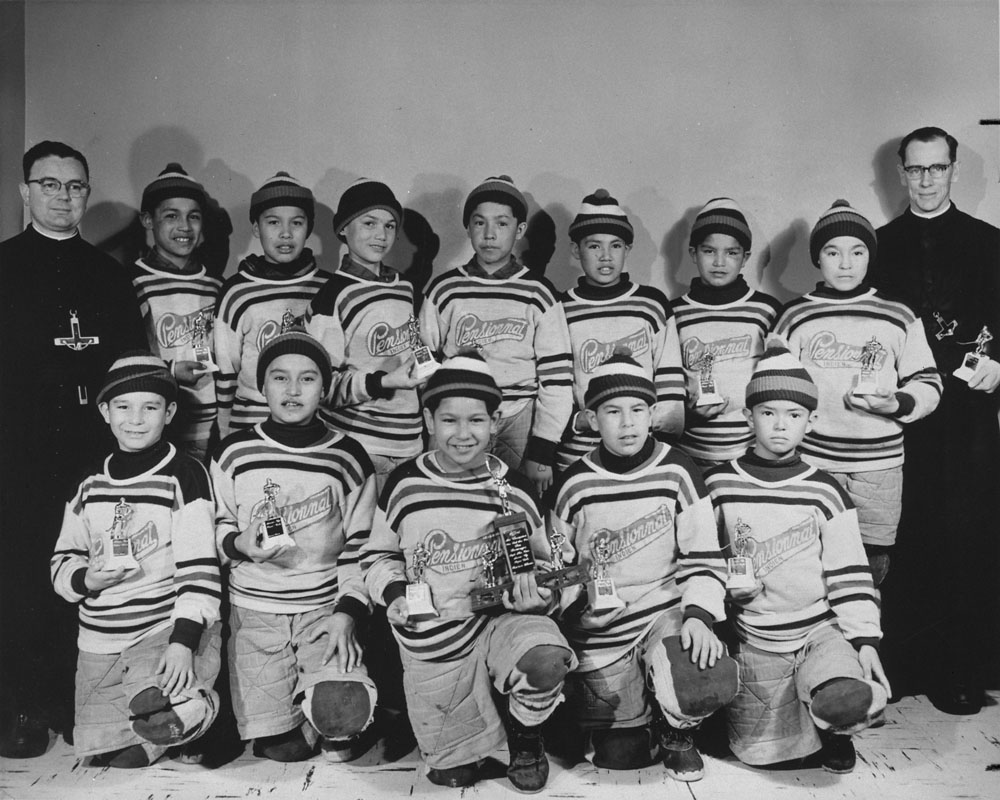
Maliotenam Indian Residential School, portrait of the hockey team and two priests, Quebec, ca. 1950 (Library and Archives Canada / PA-212964)
Sport used as a tool for assimilation
Janice Forsyth is associate professor in the department of sociology and director of First Nations studies in the Faculty of Social Science at Western University in London, Ontario. She studies how organized physical activities have been used as tools for colonization and how Indigenous people have responded to those efforts by taking up those same activities for cultural regeneration and survival.
“It’s important to understand sport in the context of colonialism and decolonization,” she says.
The Faculty of Kinesiology and Recreation Management will explore how sports and reconciliation are intertwined, something that will be discussed at the inaugural Sport & Reconciliation Gathering, which runs Feb. 21-23. Forsyth advised the Faculty on how it can make strides towards the Truth & Reconciliation Commission’s nine Calls to Action related to sport (#87 – #91) and education (#62-#65).
Forsyth unpacks the desire for reconciliation by asking: “What needs to be reconciled? Many people are unsure about what this means in sport because they have not taken the time to think critically about sport as it relates to colonization and decolonization. There is also no clear ‘road map’ to getting where Indigenous people want to go, and in most cases Indigenous people have not been put in decision-making power when it comes to developing programs and policies in a way that directly addresses their needs and aspirations. Usually their needs and aspirations get filtered through the dominant sporting lens. The need for appropriate funding that supports their aspirations is a compounding issue as well.”
She says that sport has always been used as a tool of assimilation. In the history of Canada, Residential Schools encouraged Indigenous students to participate in mainstream activities such as hockey or football instead of Indigenous activities such as lacrosse, for example.

Lacrosse players
“Sport is not value-free,” Forsyth explains. “Built into it are ways of prioritizing values and beliefs that may not be part of Indigenous cultural heritage.”
She adds: “If you shift the lens a bit, and instead see sport as a cultural activity that teaches and reinforces cultural values and beliefs, it’s not hard to see how sport has been implicated in the history of cultural transformation. In Residential Schools especially, it was used as a tool to instil dominant values and beliefs in the students who went there.”
One facet of mainstream sport that is often emphasized is that of “winning.”
“Winning is advanced as the most important part of sport,” says Forsyth. “There are different types of prestige and sometimes financial rewards that come with being a winner at a particular competition. But in some Indigenous cultures, winning is looked at differently.”
“Sport has been implicated in the history of cultural transformation”
For instance, in the far north of Canada, Elders reaffirm that winning is not the most important part of participation. The prestige of winning does no last beyond the moment of being on the podium. In a communal orientation, athletes are recognized for their accomplishments in the moment, but are discouraged from elevating themselves above the people around them. This might mean that wearing medals throughout the sporting event is not encouraged, and bragging is frowned upon.
That is only one example, and each culture will have its own ideas about what sport means and what it looks like at the community level, and what values and beliefs should be instilled through participation and competition.
“Indigenous people have always participated in sports and games, since well before the newcomers arrived on this land. It is a part of who they are. It reaffirmed their ties to land, to one another, to their spiritual beliefs, and was a source of community building and helped with their health and wellbeing, among other things,” says Forsyth. “Sport remains an important part of who they are, but their history and views are frequently distorted or lost by dominant mainstream views, and this is what needs to change. I think we’re getting there, with this learning, but the mainstream sport system has a long way to go in terms of understanding.”






